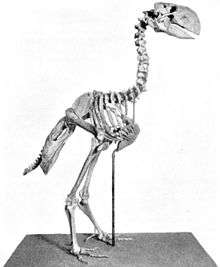Gastornithidae
Gastornithidae is a family of prehistoric birds. The various species in this group lived from the Paleocene to the Eocene epochs and ranged from Asia and Europe to North America. All known species were very large, flightless ground birds, similar to ostriches but more heavily built and with huge beaks. Once thought to be carnivores, they are now considered to have been primarily herbivorous.[1][2]
| Gastornithids | |
|---|---|
 | |
| Mounted skeleton (Gastornis giganteus) | |
| Scientific classification | |
| Kingdom: | Animalia |
| Phylum: | Chordata |
| Class: | Aves |
| Order: | †Gastornithiformes |
| Family: | †Gastornithidae Fürbringer, 1888 |
| Type species | |
| †Gastornis parisiensis Hébert, 1855 | |
| Genera | |
| Synonyms | |
| |
They apparently evolved in isolation in Europe, an island continent in the Paleocene and parts of the Eocene, before dispersing to other landmasses for a brief period of time. In this respect they resemble the elephant birds of Madagascar, also occurring in an otherwise mammal-dominated island environment where herbivorous birds exceed the largest local mammals in size.[3]
Gastornithids are only known from a handful of species. The genus Gastornis itself contains three European species, as well as the North American species G. giganteus, a well-known prehistoric bird formerly classified as the distinct genus Diatryma. An Asian species, G. xichuanensis, was originally classified as the distinct genus Zhongyuanus. Apart from these, there are some indeterminate gastornithid species, including "Diatryma" cotei from the middle-late Eocene of France.[4] Additional, fragmentary fossils that are difficult to classify in any particular genus or species include remains found in Paleocene rocks of Walbeck, Germany, and the specimen YPM PU 13258 from early Eocene rocks of Park County, Wyoming, possibly a juvenile G. giganteus[5]
References
- Witmer, L. & Rose, K. (1991) Biomechanics of the jaw apparatus of the gigantic Eocene bird Diatryma; implications for diet and mode of life. Paleobiology 17(2):95-120.
- Mustoe, G.E., Tucker, D.S., & Kemplin, K.L. (2012). "Giant Eocene bird footprints from northwest Washington, USA." Palaeontology, 55(6): 1293-1305.
- Eric Buffetaut, Delphine Angst, Stratigraphic distribution of large flightless birds in the Palaeogene of Europe and its palaeobiological and palaeogeographical implications, Earth-Science Reviews 138 · July 2014. Impact Factor: 7.89 · DOI: 10.1016/j.earscirev.2014.07.001
- Mlíkovský, J. (2002) Birds of the World, Part 1: Europe Archived 2011-03-07 at WebCite. Ninox Press, Prague.
- Wetmore, A. (1933). Bird Remains from the Eocene of Wyoming Archived 2012-03-30 at the Wayback Machine. Condor, 35(3): 115-118.